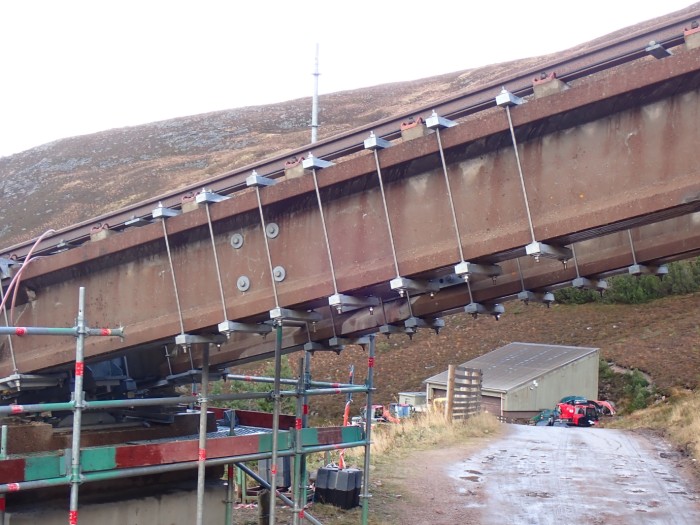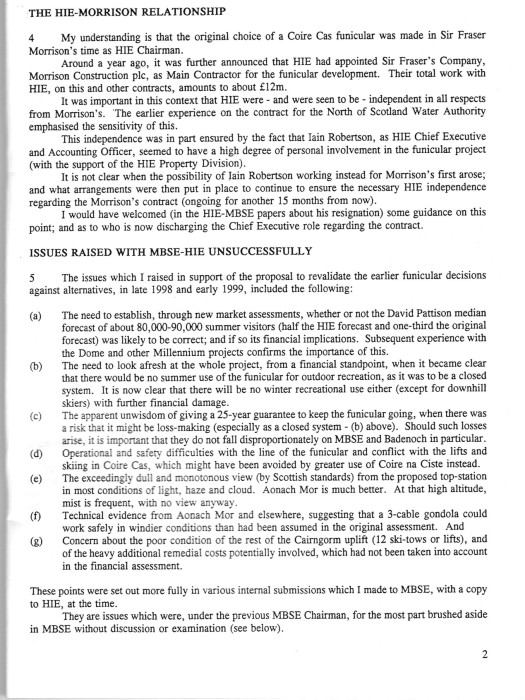
Photo courtesy of PW reader showing reinforcement of an “I” beam below the Shieling.
My first post in this series (see here) showed how the original design for the funicular was for a steel structure but it was then changed to concrete. When questioned by the Public Audit Committee about this in 2009 Highland and Islands Enterprise (HIE) claimed concrete was cheaper. This claim appears to have never been properly scrutinised, despite funiculars elsewhere generally being supported on lighter structures. In my second post (see here) I worked through the main costs and showed that concrete was the more expensive option. This post considers why HIE chose the more expensive option while, claiming it was cost-cutting exercise.
Those costs quickly escalated, as anyone with expertise in concrete production might have expected, and have subsequently escalated further when the structure, again predictably, incurred a £25,000,000 repair bill https://www.newcivilengineer.com/latest/highlands-funicular-railway-repair-bill-soars-18-11-2022/?tkn=1 between 2018 – 2023 to bring it back into working condition,
Why did HIE choose concrete rather than steel?
One possible explanation is that either HIE or the design engineers, Crudens, were incompetent and did not do the sums properly. HIE’s current court cases against Insert against Arch Henderson, who bought Crudens, and Galliford Try, who now own Morrisons, lends some support for this theory although, as this blog has explained before, the original bids were for a steel structure which were then changed at HIE’s request. Until the case is heard, the most that can be said is the successor engineering companies are denying the failure of the funicular was their fault (i.e. their incompetence)
It is worth noting here that if HIE had advertised a fixed price contract to build the funicular, either the price would have been agreed and adhered to or contractors would have refused to bid because the estimates were far too low. Instead HIE, on the advice of their consultants, issued an open-ended contract – WHY?
It is not as if working out a price for a fixed price contract was that difficult as the COWI report of June 2019 showed the estimated costs of repair to the funicular :-

And in Appendix C — Budget Price (page 83)
“Our estimated budget is £5.6m with a +1− 20% margin of error. A breakdown of these costs is included in this appendix. The above excludes the pot/spherical bearing costs as details of these are necessary for a material quote to be included in our estimate. Notwithstanding this, we have include the cost of the fixing effort ie equipment and labour to replace the bearings. We have included 5% for Risk and 3.7% RPI over the period.”
That’s quite a difference to the £25m reported to be the actual cost of the repairs/ strengthening. So why did HIE leave themselves open to spiralling costs for the repairs just as they done for the original construction?
One possible explanation is that in the case of the original construction it was deliberate. Doppelmayr, at that time an Austrian company, were involved in the original bid for a steel structure and many of the economic benefits of building the funicular would have gone abroad. From the perspective of an economic development agency whose mission was to create jobs in the Highlands, using concrete rather than steel meant more jobs locally. Establishing the likely costs of this could well have been a secondary consideration.
What subsequently became apparent was there was a very close relationship between Sir Fraser Morrison, who owned Morrison construction which built the funicular, and Iain Robertson, the Chief Executive of the Highlands and Islands Development Board (the predecessor of HIE). Sir Fraser was also chair of the HIDB while Iain Robertson subsequently moved to work for Morrisons.
It was the renowned mountaineer and access campaigner, Alan Blackshaw OBE VRD, who lived locally and was on the board of Moray, Badenoch and Strathspey Enterprise (MBSE) who first raised questions about the interests at play in a letter to J. Lochhead, the board chair, on 09/08/2000:-

Two weeks after this letter was sent, Anglian Water announced the takeover of Morrison’s:.

To get the best price for your business will ultimately depend on its turnover and gross profits. That raises the question whether the decision to change from steel to concrete was made at the very top, in a “private” deal between the two men designed not just bring jobs to the Highlands but boost Morrisons sale price. The open-ended contract and increased time scale for the construction would have been even easier for Morrison Construction to increase its turnover and profits. If true this would cast further light on Iain Robertson’s subsequent move to Morrisons.
That Sir Fraser Morrison had tried to boost the value of his firm prior to sale was later confirmed when Anglia Water sued him for fraud (see here) and (here) in a case that was eventually settled out of court. Sir Fraser Morrison incurred costs somewhere in the region of £6m defending the case and in the end handed £13m to Anglian Water, one tenth of the original claim. (Incidentally this subsequently lead to another legal battle which resulted in the Court of Session overturning a second tier tax tribunal ruling related to the case (see here)).
Unfortunately, Sir Fraser Morrison and Iain Robertson and now both dead but there may be others alive who could answer questions which would help shed more light on the explanation suggested here for why the funicular construction was changed from steel to concrete:
(1) When exactly did Anglian Water and Morrison Construction begin negotiations on the take-over bid?
(2) When exactly was Mr Iain Robertson, the CEO of HIE at that time, first approached by Morrison Construction to work for them, a job offer which he subsequently declared on 20/07/2000?
(3) When exactly did HIE or it’s consultants become aware of either of these two very important decisions?
The answers to these questions are important as (1) & (2) could have happened at the same time. No one either sells a business or changes employment overnight. In the second instance and in order to avoid a possible conflict of interest, it would have been prudent for HIE to have suspended Mr Iain Robertson with immediate effect and on full pay until the day he left.
What Needs To Happen.
There are many questions that need answering about what was going on in the early days of the funicular construction that are pertinent to the reasons for its closure in 2018 but this post suggests that the decision to change from steel to concrete is central to understanding what went wrong. If HIE continues with its cases against Arch Henderson and Galliford Try, it is possible that more of the truth will emerge in court.
The total known costs to date are in excess of £51,700,000 but there are also the hidden costs, e.g. the cost to HIE in time, Public Audit Committee inquiries etc. Considering the expenditure that has been incurred and will be necessary in the future, the whole complicated affair requires a proper investigation and deserves as much public attention as the ferries procurement fiasco.

Galliford Try and designer AF Cruden Associates have agreed to pay Highlands and Islands Enterprise (HIE) £11M after a legal case surrounding the original design and construction of the Cairngorm funicular railway was settled. https://www.newcivilengineer.com/latest/highlands-and-islands-enterprise-receives-11m-after-cairngorm-funicular-structural-defects-case-settled-17-08-2023/
So with the approx £25 million cost of building the funicular and the additional £25 million cost of repairing it ( although how long the repairs will last for is a bit of a moot point*), with the £11million repaid to HIE it will only have cost the taxpayer about £40 million (plus of course the ongoing operational subsidy that HIE acknowledge will be required)
*I’ve heard that as of this afternoon the funicular has been closed again with immediate effect?